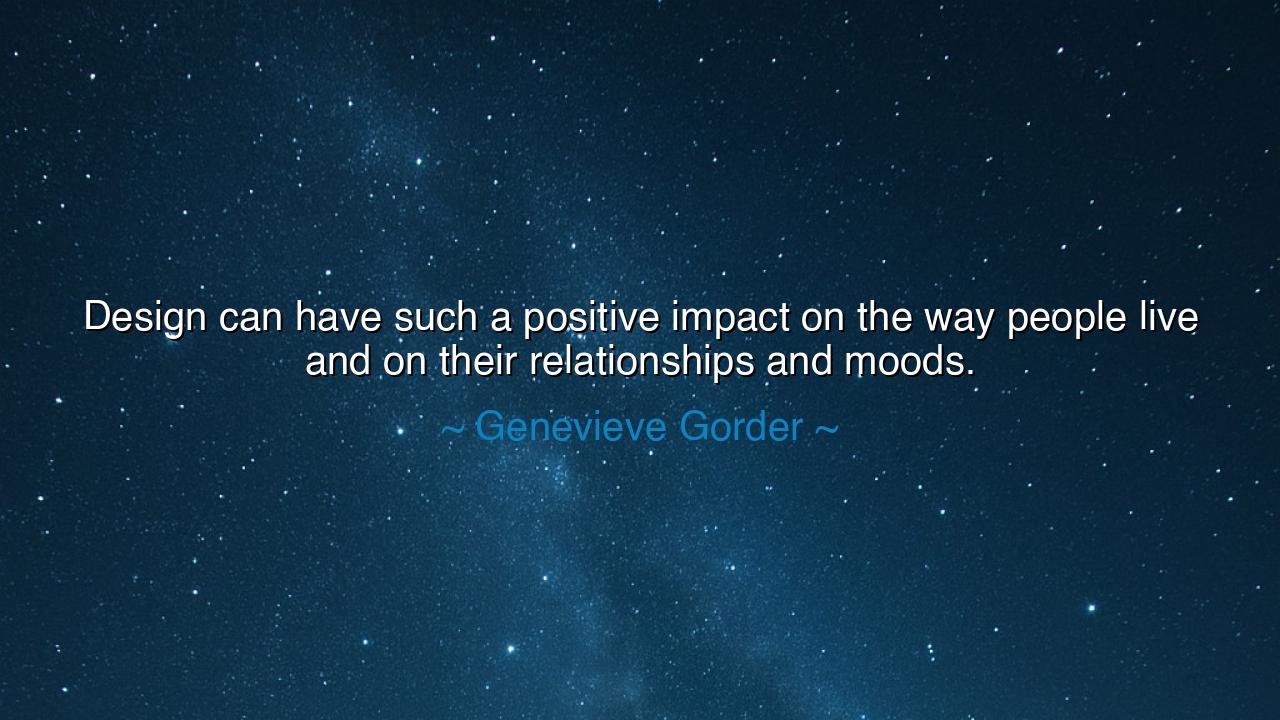
Design can have such a positive impact on the way people live and
Design can have such a positive impact on the way people live and on their relationships and moods.






In the tender yet powerful voice of one who shapes both space and soul, Genevieve Gorder once proclaimed: “Design can have such a positive impact on the way people live and on their relationships and moods.” At first, these words may seem simple—an artist speaking of her craft. Yet to those who listen deeply, they reveal a truth far greater than design alone: that beauty, order, and intention are not luxuries of life, but necessities of the spirit. For in every home, in every room, in every space we build around us, we mirror what lives within us. The external world—if shaped with care—becomes the silent companion of our inner peace.
To understand the origin of this quote, we must know the woman who spoke it. Genevieve Gorder, celebrated designer and television personality, rose to prominence through her work on design programs such as Trading Spaces and Dear Genevieve. Yet her wisdom was never confined to aesthetics alone. Having traveled the world, she learned that the true essence of design is not found in grandeur, but in empathy—in the understanding that design touches human lives at their most intimate levels. She observed that the color of a wall, the placement of light, or the feel of a chair are not trivial choices, but acts of care that shape emotion, connection, and daily joy. In this, Gorder stands not merely as a designer, but as a philosopher of the human environment.
The ancients, too, understood this sacred relationship between space and the soul. In ancient Greece, the architect was seen as a moral craftsman, for the structure of a city reflected the structure of its values. Vitruvius, the Roman architect, wrote that architecture must possess three virtues: firmitas (strength), utilitas (function), and venustas (beauty). These principles were not about mere building, but about balance—the harmony between body, mind, and world. What Genevieve Gorder expresses in modern words, the ancients knew in timeless wisdom: that our surroundings have the power to lift or diminish us, to bring forth joy or despair. Design, in this sense, is not decoration—it is medicine for the human heart.
Consider, for example, the story of Florence Nightingale, the founder of modern nursing. During the Crimean War, she noticed that soldiers recovered faster in hospitals filled with sunlight, clean air, and calm colors. She redesigned wards to maximize natural light and airflow, and soon survival rates rose dramatically. Nightingale’s insight became the foundation of modern healthcare design—a living testament that environment shapes wellness. Her work, though rooted in medicine, was an act of design guided by compassion. Like Gorder, she understood that the spaces we inhabit can heal or harm, soothe or suffocate. Both women remind us that beauty is not frivolous—it is a form of love made visible.
In every home, in every community, this truth endures. A well-lit kitchen invites laughter; a welcoming doorway nurtures connection; a calm room can quiet a restless heart. To design with intention is to honor life itself. When Genevieve Gorder speaks of design’s impact on relationships and moods, she invites us to recognize that the spaces we create shape the way we treat one another. A crowded, chaotic space breeds impatience; an organized, serene one cultivates harmony. The ancients built temples not just for gods, but for the soul’s ascent. Likewise, when we design our surroundings with care—be it a home, a classroom, or a city—we create temples for our own humanity.
But her words also carry a moral challenge. They remind us that neglecting design is a kind of neglect for the self and others. To live among ugliness, disorder, or indifference is to dull our spirit. Design, when approached with love, demands attention, curiosity, and humility. It asks: How do others feel here? What do they need to thrive? In this way, design becomes not the pursuit of perfection, but an act of empathy and stewardship—the same virtues that have sustained civilizations and bound families together for millennia.
So let this be the teaching drawn from her words: to design is to care. Whether you build a house or simply arrange a table, do it with intention. Let light enter your spaces. Choose colors that lift your heart and materials that tell your story. Shape the world around you as a reflection of the peace and kindness you wish to see within. For as Genevieve Gorder reminds us, design is not about luxury—it is about life. It is the bridge between the visible and the invisible, between the world we inhabit and the spirit that inhabits us. When we honor this, when we make our surroundings an extension of our love, we will find that beauty does not merely decorate our days—it transforms them.






AAdministratorAdministrator
Welcome, honored guests. Please leave a comment, we will respond soon